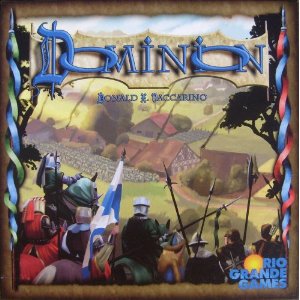Playing the Dominion Card Game
Dominion has changed card games for me. I know that’s a bold statement, but it’s true. When I was first introduced to Dominion, I had heard a few things about it. Some said it was a deck building game, like Magic: The Gathering. Others said that it was a resource hoarding game like Settlers of Catan. Others said that it was a cutthroat game where the main purpose was to mess up other people’s play.
At times, they were all right.
How can this be? It is the unique game play that separates Dominion from those previously mentioned games, while aspects are similar to all of them. It is the first game that is suggested when friends come over to play games, and if it happens to come out, it tends to be the last game played, as we stop looking for anything else to do.
Dominion Rules, Instructions

Everybody starts with the same deck. That deck consists of ten cards, seven of them are single coins, and three are victory points. On your turn, there are only three things you can do, but you’re going to want to try to do them a lot.
The first is take an action, but it’s going to take a couple turns before you can take an action.
The second thing you can do is buy from the randomly selected ten ‘stockpiles’ that are on the table.
The last thing you do is discard every card that you have played, from actions to money, and redraw up to five.
That’s it. It sounds horribly simple, doesn’t it?
After two hands, you have played your entire deck, so it is time to reshuffle everything and start again. Now, the cards you purchased in your first two turns are live in the deck, and will come out within the next couple turns. The cards you bought are going to give you actions like ‘+1 ACTION’ or ‘+2 CARDS’ which means that upon playing one action you can promptly play another, or in the latter case, draw 2 cards. The more coinage it took to buy a card, the more powerful it is (usually).
As the game progresses, you buy higher powered coinage, with a value of 1 to 3, and inevitably buying more victory point cards, with values of 1, 3, or 6. The minute the 6 point cards are gone (The Province), the game is over. (The other game ending condition is that three individual piles of other cards are gone.) The minute that last card is picked up, the player finishes her turn, and everybody adds up their victory points. The highest victory point score wins, with their amount of gold being the tie breaker.
That may sound complex, and at first the concept seems daunting for people used to the standard collectible card market. There are no cards (in the initial set) that remain out at the end of your turn. Nothing is long lasting or static in Dominion, and each turn it becomes the luck of the draw combined with your purchasing strategies.
The real power of Dominion is that the core set comes with 25 non-coin and non-victory cards (sometimes referred to as Kingdom cards). That means that any combination of 10 of those 25 cards might be on the game table at the beginning. No strategy is guaranteed to be present when you sit down to play. One spread might dictate that you spend your time building a deck that draws as many cards as possible, where another might allow for you to be able to buy more than one card per turn. When you add any of the major expansions, your selection doubles.
Dominion Strategy & Tips
Trying to pin down one specific Dominion strategy is hard, given the variable nature of the game. Every game is going to have a different set of cards, so finding strategies are going to be very different per game. There is one strategy that many people do consider, and that is the ‘ignore the cards’ method.
The one flaw in the game is that at times, you might not see a viable strategy for buying cards quickly. If that ever happens, simply buy money with your cards. Buy silver until you start getting enough for gold, then buy gold. When you feel that you have enough money, start buying victory point cards and do so until the end of the game. While other people are buying up the Kingdom cards, trying to make long combinations of cards, you’re keeping it simple. This strategy might not always work, but if you are stuck, it is definitely worth a shot.